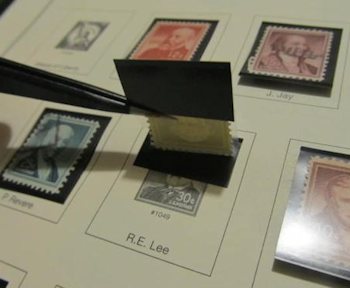The Stamp Collection
Something that came up in the Neocities comments recently—and something that I had completely forgotten about myself—is that I had a stamp collection when I was young.
Now, I would not go so far as to say I collected stamps. But I had a stamp collection. This is a key distinction.
This was so long ago that I can’t recall exactly how it started. I can nearly guarantee I never wanted a stamp collection. While I admit that I had my share of baffling and untenable desires as a child, I have difficulty picturing a world where stamps were something I yearned for. However, I suspect I can trace the roots of this collection back to my formative years in the Cub Scouts, which, for the unfamiliar, is pretty much “Boy Scouts, but for pre-teens”. You can see why the Boy Scouts of America would want to develop such a program, because A) that’s twice as many years of selling you overpriced uniforms and pinewood derby kits and shit, and B) it’s more reliable to pull you into the system when it’s your mom signing you up, rather than expecting you to decide at the age of 12 that you want to spend your Tuesday evenings learning how to whittle.
I’m pretty certain the Cub Scouts were involved because if you wanted to progress through the ranks, you had to become a well-rounded, model child by completing all manner of requirements across many various vocations (or at least scraping by with as little effort as you could get away with); and looking back on it, these requirements seemed to be really good at locking me into doing things I didn’t actually want to do. For example, although I played two years of youth recreation soccer during this time, I distinctly remember not wanting to do the second year, largely because I had reached the point in my life where my body was deciding that, actually, being able to run for 30 seconds without growing winded was overrated, and wouldn’t we be much happier just having self-esteem issues the rest of our life instead?
In the end, nobody was particularly pleased at me signing up for that second year of soccer, least of all me. Given the fact that I tended to spend two out of four periods every game sitting on the bench—more than everybody else, and I suspect, the most allowed by league policy—my coach would have preferred to cut me from the team if he’d had the power to eject a hapless kid from a recreational league. This meant my mom was carting my ass around to practices and matches just to watch me spend half the game not playing; I don't assume she was very enthusiastic about this. However, in my eyes, sitting on the bench was a sweet mercy, because in spite of my clear and embarrassing lack of cardiovascular endurance the coach had decided I would cause the least amount of damage playing midfield, a position that requires covering both sides of the pitch and constantly running back and forth along 80% of its length. If given the choice, I would have played goaltender, or alternately defense; but in the end, my pleas were unheard, and I spent the season growing to despise the position I had been relegated to in the increasingly rare instances I was allowed to play.
As I write this I realize why, throughout the entirety of my high school career, I eagerly volunteered to be the goalie in every net-and-field sport we played in gym class: soccer, field hockey, street hockey, lacrosse, you name it. In my broken little brain, using my body to block incoming projectiles—without any protection, I might add, because the school didn’t have the funds for it—was less painful than the psychological torment of having to run around for 20-30 minutes.
I’m getting off-track here, but I think you can see how the Cub Scout program is a likely culprit behind how I ended up possessing a stamp collection while lacking any interest in possessing said stamp collection. I’m sure that somewhere along the way, my guide book said (paraphrasing here) “if you want this badge, you need to have a collection of something”, and apparently my chest full of assorted Lego bricks didn’t count.
But why stamps, of all things? Alas, thanks to my poor memory, this requires even more speculation than before. I can, however, easily picture a world wherein my mother, being equally as exasperated with this process as I was, started rattling off popular types of collections for lack of any better ideas:
- Insect collecting? Ick. Who wants to catch, gas, and pin up bugs for the pleasure of looking at dead bugs?
- Coin collecting? Hey, this is circa 1999; a quarter from the Tooth Fairy in exchange for a bicuspid still gets a kid a lot of buying power. If I’m gathering loose change, it’s just so I can turn around and spend it.
- Stamp collecting? …Well, hey, stamps come to the house attached to mail all the time. We’re just throwing them out. This will be easy!
Obviously, I did not put a lot of forethought into this idea (although in my defense, I did not want to do the idea in the first place). Corporate mailings tended to be pre-paid and didn’t include postage. Anything else that might be lumped into a group generously labeled “personal mail” was likely to be using the 32-cent standard with the American flag design. Well hell, my dad kept two rolls of those in the stationary drawer, I didn’t need to collect them from envelopes. Maybe if I was lucky I’d see some seasonally-appropriate designs attached to Christmas cards. Not to mention, if this is your approach, you’re only ever going to see stamps as old as anybody happens to have sitting around the house. What about the rich and varied history of stamp designs ripe for the collecting?
This presents something of an issue to a child who lives 45 minutes away from the nearest major metropolitan area, which itself barely cracks the Top 10 list of most populated cities in the state. We’re also a good five years out from reliable online shopping. Where the hell do you even get stamps? (aside from the post office, that doesn’t count)
Thankfully, this was a solved problem by the late 90s. It’s time to talk about Mystic Stamp Company.
I’m sure this was one of those companies from this era that sent unsolicited catalogs to your address, or advertised in the back of magazines or on local television stations, something to that effect. It could have been one of these advertisements that put the idea into my mother’s head in the first place; again, I was so divested from this process that my parents were doing all the legwork in arranging this collection just so I could cross off the stupid checkbox.
But wouldn’t you know it, Mystic Stamp Company sold stamps via mail-order! All kinds of stamps, from all eras, at prices I can only assume were egregious!
And conveniently, they also sold branded albums and materials to safely mount and protect your stamps, again at prices I would probably be outraged by today!
(It doesn’t escape me how, in reliving all these distant and nearly-forgotten childhood memories of activities I engaged in, instead of allowing myself to indulge in the warm veneer of nostalgia all I’m capable of feeling is unrepentant, biting cynicism. No wonder I’m so goddamn depressed.)
Here’s how it worked: Mystic Stamp Company sent you an album full of pre-printed pages, organized chronologically and by collection, each with black-and-white images of stamps that would act as a placeholder until you acquired the real thing. 99% of these placeholders would never be filled in, but I guess it was a cool way to get you excited about the stamps you could possibly obtain, assuming it is possible to be excited about stamps (it is not). Of course, you don’t just affix the stamp to the page using its built-in adhesive, because then it would ruin the resale value (in the unlikely event your next-of-kin finds a willing buyer for that particular stamp). Instead, you buy these plastic mounts that are folded on the top and bottom and have a clear panel on the front; insert the stamp, adhere the back of the top fold to the page over the placeholder, and you have a relatively secure system for storing that piece of history you’re going to place onto a bookshelf and never look at again.

I know the stamps themselves came from Mystic; I don’t know how they were chosen, because, as should not be a surprise at this point, I did not pick them out myself. I wasn’t excitedly sitting down with the Mystic Stamp catalog and a felt-tip marker the same way we all did with the Sears Wish Book three weeks before Christmas. As best as I can recall, there never seemed to be any rhyme or reason to what stamps I received from what collections, and it’s easy to guess that they had “assortment” packs made up of excess inventory that they charged slightly-less exorbitant prices for, making them appealing targets to beleaguered parents trying to get their 11-year-old son to show an interest in literally anything besides his Game Boy.
I do remember evenings spread out uncomfortably on the living room floor (because I hadn’t yet grown a brain and realized I could do this at the damn table), retrieving a stamp from the pile, flipping through pages in my album until I found wherever the hell this one was supposed to live, wrangling it into its plastic mount, and affixing it into its proper place, then repeating the process ad nauseum, all the while wishing I could be doing something more fun, like math homework, or cleaning my room. I know I reached a point where stamps kept coming in (why were we still buying these?!) and I was just putting them aside, figuring I’d get around to organizing and mounting them later.
I never did. Conveniently, the entertainment center that held our TV had two cabinets underneath—a perfect place for hiding away stamp albums where I never had to think about them ever again. I did make it through the entirety of the Cub Scouts and graduated into the next tier of scouting, but once it became evident that the Boy Scouts were going to require actual investment on my part, I bailed and dedicated myself to video games full-time.
Turns out, Mystic Stamp Company is still around, doing pretty much the exact same thing they were doing back then. Look, you can even get the same cheap 3-ring binder filled with what look to be the same placeholder pages they sold 25 years ago. $40 for a single volume, collect all six.

Photo credit: Mystic Stamp Company
They’ll also sell me one of those 32-cent American flag stamps brand-new for $1.30. Who needs to invest in stocks when you can invest in postage stamps.
I’m not exactly sure what became of the stamp “collection”. I moved on to college without giving it a second thought. I believe my dad asked me fairly recently if I wanted it. I told him he could sell it. Seems fair; it was probably his money that paid for it all, anyway. Maybe he could recoup some of the losses.
But, who can say. He might still have it, and I’ll find it later on down the road when I’m in the process of carrying out his will, probably tucked away forgotten in the attic somewhere. Or maybe he’s taken it upon himself to fill out the blank pages, scouring auctions and estate sales for the odd postage stamp that would be insignificant to most people today.
In which case, good. That man needs a hobby.